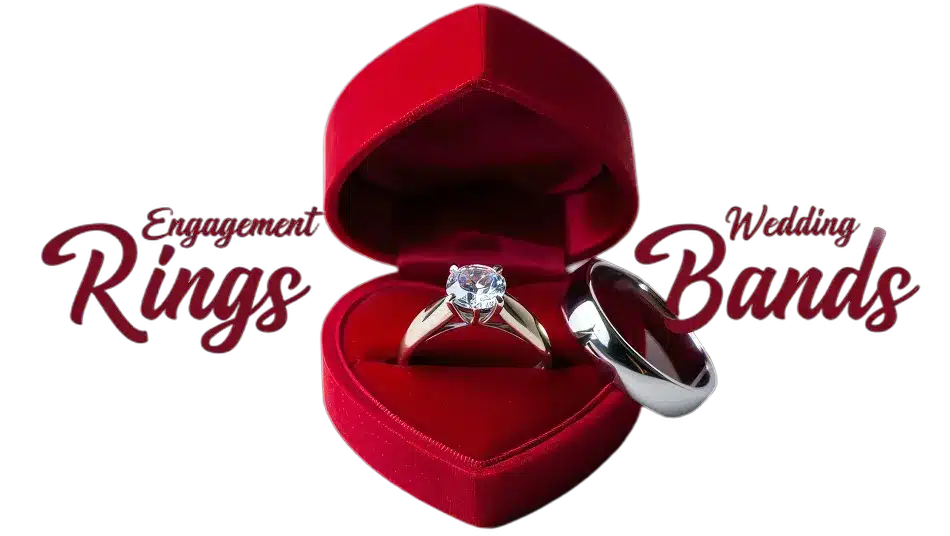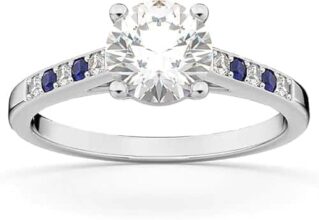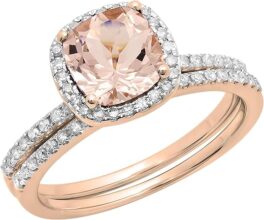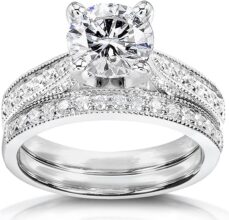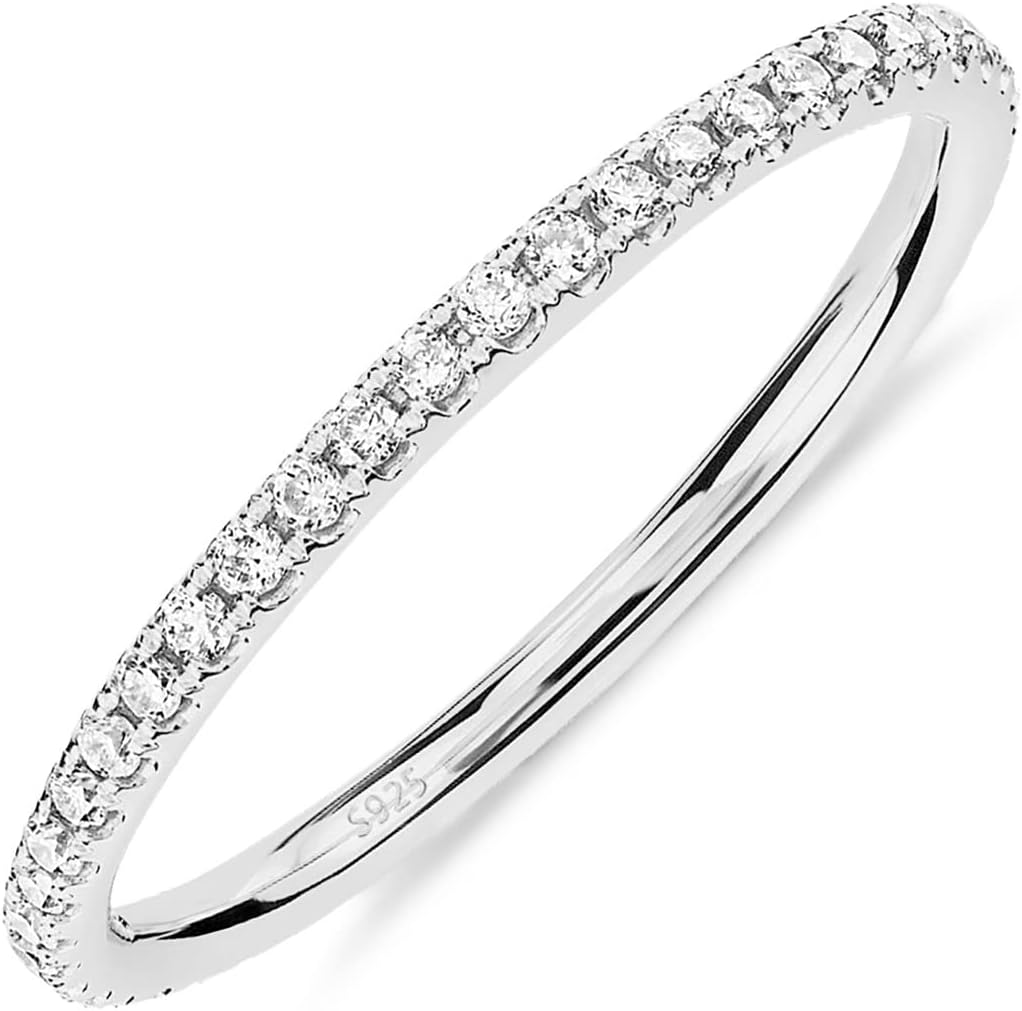
Understanding the Basics of Engagement Rings and Wedding Bands
When it comes to love, the details matter—especially when it comes to rings! Have you ever wondered about the key differences between engagement rings and wedding bands? Each carries its own unique significance and charm, making them essential symbols of your journey together.
In this article, you’ll explore what these rings represent and their distinctive designs. You’ll learn about the appropriate times to wear each ring and how to select the perfect metal and material that reflects your style. Plus, we’ll cover important budgeting tips to help you navigate this exciting purchase.
By the end, you’ll feel empowered to make informed decisions about the rings that will adorn your fingers and signify your commitment. Let’s dive in and uncover the beautiful nuances that set engagement rings apart from wedding bands!




The Symbolism Behind Engagement Rings and Wedding Bands
When you think about engagement rings and wedding bands, it’s important to recognize that these beautiful pieces of jewelry are not just accessories; they are profound symbols of love and commitment.
Engagement Rings: A Promise of the Future
The engagement ring is typically given during a proposal, and it represents a promise for the future. It signifies that one person has asked another to enter into a lifelong partnership. This ring is often more ornate and includes a significant stone, typically a diamond, that catches the light (and attention!). The sparkle of an engagement ring embodies the excitement and joy of that cherished moment when two lives are about to intertwine.
Imagine getting down on one knee and seeing the surprise and joy on your partner’s face; that sparkling diamond becomes a testament to your love story. Beyond its beauty, the ring is a conversation starter, a piece that tells the world about your commitment.
Wedding Bands: An Unbreakable Bond
On the other hand, wedding bands symbolize the vows exchanged on the wedding day—the ultimate commitment to love and cherish each other. Typically simpler in design, a wedding band is often worn daily and is seen as an everlasting token of devotion. The circular shape of a wedding band is significant; it represents eternity and the idea that love has no beginning or end.
When you slip that wedding band onto your partner’s finger, it’s not just metal and gemstones; it’s an affirmation of a promise made in front of loved ones. Think about the joy of your wedding day: standing at the altar, with family and friends gathered around, knowing that this ring will signify your lifelong journey together.
A Combination of Symbolism
Together, these rings tell a story. The engagement ring marks the beginning of the journey, while the wedding band celebrates your shared commitment and the life you are building together. Each ring has its own meaning and place in your relationship, and both should resonate with your personal love story.
Understanding the symbolism behind these rings can help you appreciate their importance as you move toward the next part of your journey—finding the perfect design that suits your style and relationship. In the next section, we will explore the design differences between engagement rings and wedding bands, highlighting what makes each unique.
Design Differences: How They Vary in Style
When it comes to the design of engagement rings and wedding bands, you’ll quickly discover that they cater to different aesthetic preferences and serve distinct purposes. Understanding these differences can greatly assist you in choosing rings that beautifully represent your love story.
Engagement Rings: The Center of Attention
Engagement rings are often designed to captivate. Their standout feature is typically a prominent center stone, often a diamond, which radiates brilliance and allure. The settings can vary significantly—from solitaire settings that emphasize a single gemstone to intricate halo designs that encircle the center stone with smaller diamonds, creating a dazzling effect.
Popular Styles:
An excellent example is the Twisted Vine Moissanite Engagement Ring, which showcases a brilliant design that draws in the eye, capturing the essence of your proposal moment beautifully.
Wedding Bands: Timeless Elegance
In contrast, wedding bands are generally more understated, focusing on simplicity and durability for everyday wear. Their designs often feature smooth metal bands, but they can also include subtle embellishments like engravings or accent stones. The emphasis is on a comfortable fit and a look that seamlessly complements the engagement ring.
Popular Styles:
Complement Each Other
When selecting your rings, think about how they will harmonize. Engagement rings are often more elaborate, while wedding bands provide a lovely contrast, underpinning the engagement ring’s glamour. Consider visiting jewelers to try various styles together—seeing them side by side can inspire the perfect combination that feels just right.
Personal Taste Matters
Ultimately, when choosing your rings, let your personal taste guide you. Whether you prefer the grandeur of an engagement ring or the subtlety of a wedding band, make sure it resonates with your relationship. Think about styles that reflect your personality and the love you share. This consideration will ensure that both rings become cherished tokens of your journey together.
As you navigate the choice of style, it’s also important to consider the materials you’ll select for your rings. In the upcoming section, we’ll explore how different metals and materials can enhance the beauty and longevity of your chosen designs.
When to Wear Each Ring: The Timeline of Love
Understanding when to wear your engagement ring versus your wedding band is crucial, as each ring marks a significant moment in your romantic journey. Let’s break down the traditional timelines, the occasions for both rings, and how they are typically worn throughout your life together.
Engagement Ring: The Prelude to ‘I Do’
Typically, you’ll wear your engagement ring from the moment your partner asks you to marry them. This ring serves as a clear symbol of your engagement and commitment. Whether it’s sparkling on your finger while at brunch with friends or on full display during special occasions, the engagement ring is meant to be flaunted!
It’s not just about wearing a ring; it’s about celebrating the promise of a future together. Most people wear this ring all the way up until the wedding. Just remember, if you’re planning to wear your engagement ring on your wedding day, think about how it will stack with your wedding band!
The Wedding Day Switch
Once you say “I do,” the wedding band becomes the star of the show. Traditionally, the wedding band is placed on the finger first during the ceremony, right before the engagement ring, symbolizing the vows you’ve just exchanged. Many individuals choose to reposition their engagement ring to sit above their wedding band, creating a beautiful stack that shows both your commitment and your love.
On this day, you might want to ensure both rings are polished and prepped! After all, this is a moment where the rings take center stage—not just during the ceremony but also in the beautiful memories captured in photos and videos.
Daily Wear: A New Routine
After your wedding, you’ll probably find yourself wearing both rings daily. Many couples choose to always wear their wedding band, as it represents the unity and promise of marriage. The engagement ring may also become part of your everyday ensemble, or you might decide to wear it only on special occasions—like anniversaries, date nights, or holidays—keeping the sparkle alive without worrying about wear and tear.
Special Occasions
While both rings can be worn daily, special events often call for extra sparkle. Your engagement ring can take a front seat during anniversaries or romantic trips, serving as a lovely reminder of your love story. If you find yourself taking off your rings during activities like exercise or swimming, make it a practice to replace them right after to keep them close to your heart.
As you settle into your new routine, the importance of the materials and metals that compose your rings will start to weigh on your mind. In the next section, we’ll explore how to choose the right metal and material to ensure that your rings remain as stunning as the day you exchanged them.
Choosing the Right Metal and Material
The choice of metal can significantly affect both the look and durability of your engagement ring and wedding band. Understanding the materials available is crucial in selecting rings that not only fit your style but also withstand the test of time. Let’s explore the most popular options and how to choose what’s best for you.
Gold: The Timeless Classic
Gold remains a favorite for both engagement rings and wedding bands. It’s available in several colors, notably yellow, white, and rose gold. Each color carries a distinct charm:
When selecting gold, you’ll also come across different karat options (e.g., 14k, 18k). Higher karat gold is softer and more malleable, making it more prone to scratches but also richer in gold content.
Platinum: The Luxury Metal
If durability is your priority, consider platinum. Known for its strength and longevity, platinum is resistant to tarnish and wear. It’s the ideal choice for someone with a hands-on lifestyle, ensuring that your ring remains as flawless as the day you received it. Platinum’s natural white sheen also enhances the brilliance of diamonds, making it a popular choice for engagement rings.
Alternative Metals: A Modern Twist
For those looking for something different, alternative metals such as titanium, cobalt, and tungsten are gaining popularity. These materials are often more affordable while providing a unique, contemporary look:
Finding a Balance
When choosing the right metal, consider your lifestyle, personal style, and budget. If you’re active or work with your hands frequently, opting for a more durable material like platinum or titanium can help your rings withstand daily wear. Alternatively, if you have an affinity for a traditional look and want something timeless, gold may be your best bet.
Final Thoughts on Material Selection
Whatever material you end up choosing, make sure it resonates with your personality and fits the overall design you have in mind for your rings. The right choice will enhance their charm while ensuring their longevity throughout your journey together.
As you reflect on these options, keep in mind that the relationship between your rings and your unique love story is paramount. In our next section, we will discuss budgeting for your rings, equipping you with insights to make informed financial decisions without sacrificing quality or style.
Budgeting for Your Rings: What to Expect
Buying rings can be a substantial investment, but it doesn’t have to break your bank. Understanding the costs associated with engagement rings and wedding bands, along with some practical budgeting tips, can help you balance quality and affordability while getting the dream rings that symbolize your love.
Average Costs: What to Expect
Engagement rings can vary widely in price, influenced by factors such as the type of stone, brand, and design. On average, you might spend:
Remember, these are simply averages—many people find stunning rings under these amounts, and others may choose something more extravagant. Estimate your total budget. Setting aside funds specifically for rings can help streamline the process.
Budgeting Tips
To make ring shopping more manageable, consider these budgeting strategies:
Set a Clear Budget: Determine how much you can comfortably spend. Knowing your limit can prevent overspending and guide your choices.
Prioritize Your Preferences: Decide which features are most important to you. Is the stone size paramount, or do you prefer a unique design? Understanding your priorities can help you allocate your budget effectively.
Do Your Research: Look into different jewelers. Compare prices, styles, and materials. Online retailers often have competitive pricing and can provide valuable benchmark information.
Consider Alternative Stones: For the engagement ring, consider gemstones like sapphires, morganite, or lab-created diamonds. They can provide a unique twist at a fraction of the cost of traditional diamonds.
Think About Metal: As discussed earlier, the metal choice can significantly affect the price. For instance, rose gold may be less expensive than platinum, while still offering a beautiful aesthetic.
Balancing Quality and Affordability
You don’t have to choose between quality and budget—finding a ring that checks both boxes is possible! Here are some tips to help balance the two:
Final Thoughts on Budgeting
Investing in your rings is an important step in your love journey, but it doesn’t have to overwhelm your finances. Understanding the average costs and keeping an eye on budgeting can empower you to make informed choices without sacrificing your vision. In the upcoming section, we’ll wrap up our discussion and provide you with final thoughts on selecting the perfect rings that will beautifully represent your lifelong commitment.
Final Thoughts on Choosing Your Rings
With a clearer understanding of the differences between engagement rings and wedding bands, you’re now better equipped to choose the perfect symbols of your love and commitment. Each piece tells a unique story—one of promise and the other of unity. Remember to consider your personal style, the significance of each ring, and your budget as you navigate this exciting journey.
As you embark on this special chapter of your life, take the time to explore options that reflect your relationship’s unique qualities. Whether you opt for classic elegance or bold innovation, the right rings will celebrate your love for years to come. Happy ring shopping!
